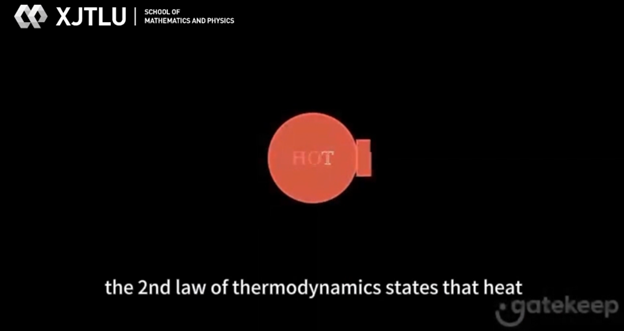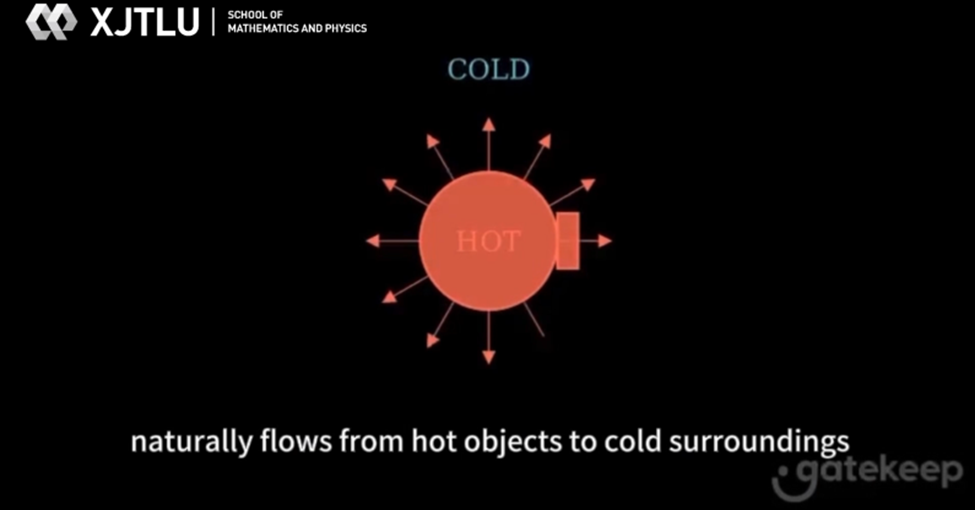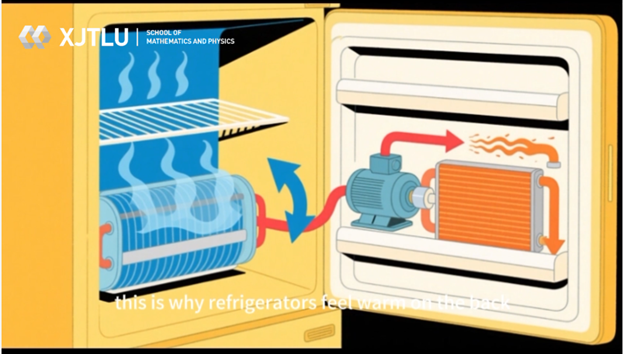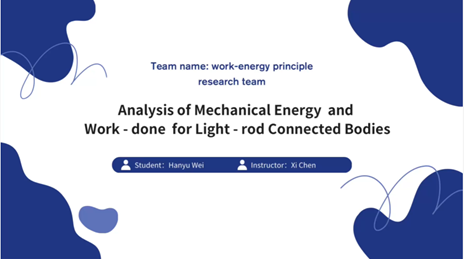



The process of solving physics problems is usually serious. However, through this small interlude, I could capture the attention of students who had been distracted. Upon seeing the illustrations and participating in the voting, they began to listen attentively, with some even smiling as they continued to listen to my subsequent explanations. Thus, I believe that my goal of enhancing student engagement has been achieved without consuming too much lecture time, while this series of images could serve as a catalyst for in-class discussions and enliven the classroom atmosphere. Meanwhile, I also encouraged the students to generate their own example-related pictures by XIPU AI to help solidify their memories.
2. Designing an Assignment with XIPU AI Usage
To further leverage AI in the learning process, an AI Physics Video Competition was designed as an optional extra credit assignment. Students could choose any subject within the content of the PHY001 module and create videos that demonstrated their understanding and application of physics concepts. They were allowed to form groups of up to three individuals and were provided with safety instructions to ensure their well-being during the video creation process.
XIPU AI was used to provide options for the competition's title, prepare safety instructions, and edit the assignment announcement draft, including the "Rubrics for Marking the AI-Generated Videos." The rubrics, generated by XIPU AI, included criteria such as “Understanding of Core Knowledge, Experimental Verification and Application, Concept Application, Mathematical Representation, and Use of Scientific Method”. I would like to mention that XIPU AI is really good at writing Rubrics and it even gives some additional notes, emphasizing the importance of clarity, creativity, and technical quality in the videos, which I think are very thoughtful and useful (The rubrics and additional notes given by XIPU AI are also shown in the Appendix).
With the support of our department (Department of Physics) and our school (School of Mathematics and Physics), an award ceremony for the AI Physics Video Competition was organized to celebrate the hard work and achievements of our students. Prize-winning students were invited to give presentations to showcase their projects and share their experiences at the ceremony. In preparation for the award ceremony, I also used XIPU AI to generate some images for the opening and closing backgrounds (Figure 3-4).

Figure 3. The opening slide used for the Award Ceremony of the AI physics video competition

Figure 4. The closing slide used for the Award Ceremony of the AI physics video competition
Results and Tips
Student Engagement and Learning Outcomes
The AI Physics Video Competition saw active participation from students, who demonstrated their creativity and physics knowledge through engaging video production and innovative use of AI tools. The quality of the videos exceeded expectations, as evidenced by the three prize-winning videos (Figure 5-8). A post-competition survey conducted on the Learning Mall Core platform indicated that a majority of students strongly agreed that the videos enhanced their understanding of physics and expressed a preference for more such activities in the future.


Figure 5. Captured pictures of the video of the first winner: the student created a video to explain the Second Law of thermodynamics in physics


Figure 6. Captured pictures of the video of the first winner: the student used AI to generate interesting pictures for the video production to explain daily phenomena and the application of the physical law.


Figure 7. Captured pictures of the video of the second winner: the student created a video to explain Faraday’s Law of Electromagnetic Induction in physics, using AI to generate pictures and narratives to explain its applications.



Figure 8. Captured pictures of the video of the third winner: the student created a video to explain mechanical energy in physics and a problem related to the work done for light-rod connected bodies. At the end of the video, it shows how AI was utilized in the video creation.
Insights and Suggestions
Personalized Learning: AI-generated images and videos can be tailored to individual student preferences, making learning more personalized and engaging. Each student has unique learning styles and interests, and AI can help create content that resonates with them on a personal level. For example, some students may prefer visual aids with humorous elements, while others might benefit from more realistic or detailed illustrations. By allowing students to choose the type of AI-generated content they find most engaging, educators can foster a more inclusive and personalized learning environment. Additionally, encouraging students to create their own content using AI tools not only enhances their understanding of the subject matter but also empowers them to take ownership of their learning process. This active involvement can lead to better retention of complex concepts and a deeper sense of achievement.
Active Learning Strategies: Involving students in content creation is a powerful way to promote active learning and deeper comprehension. The AI Physics Video Competition, as demonstrated in this study, provided students with an opportunity to apply their knowledge of physics in a creative and practical manner. By working in groups to produce educational videos, students were able to collaborate, communicate, and think critically about the concepts they were learning. This hands-on approach not only reinforced their understanding of physics but also developed essential skills such as teamwork, problem-solving, and digital literacy. The active learning strategies can help students stay engaged and motivated, making the learning process more enjoyable and effective.
Technical and Pedagogical Integration: The seamless integration of AI tools into teaching materials and assignments can significantly enhance the quality of educational content and save valuable time for educators. In this study, XIPU AI was used to generate images, create rubrics, and draft assignment announcements, demonstrating its versatility and usefulness in various aspects of teaching. By leveraging AI for these tasks, educators can focus more on designing meaningful learning experiences and providing personalized support to students. This integration can lead to more efficient and effective teaching, ultimately benefiting both educators and students.
Safety Considerations: Ensuring student safety during AI-assisted activities is of utmost importance. While AI tools offer numerous benefits, they also come with potential risks, especially when it comes to student well-being. In the context of video creation, students may face physical risks such as injuries from unsafe experiments or improper use of equipment. To mitigate these risks, educators must provide clear guidelines and safety instructions before any AI-driven projects commence. Additionally, it is crucial to monitor students' progress and provide support whenever necessary.
Student Feedback and Iterative Improvement: Student feedback is invaluable in evaluating the effectiveness of AI-integrated teaching methods. Regular surveys and open discussions with students can provide insights into their learning experiences and preferences. We should be open to feedback and willing to make adjustments based on students' input. This iterative improvement process can help refine AI applications in education, ensuring that they meet the evolving needs of students. By actively involving students in the evaluation and improvement process, educators can create a more responsive and effective learning environment that leverages the full potential of AI.
Collaboration with Technologists and Researchers: Educators should collaborate with technologists and researchers to stay at the forefront of AI developments and explore new ways to integrate AI into education. Technologists can provide expertise on the latest AI technologies and their capabilities, while researchers can offer insights into the effectiveness of AI in different educational contexts. By working together, educators, technologists, and researchers can develop innovative solutions that address the challenges of modern education and enhance the learning experience for students. This collaboration can also lead to the creation of new AI tools specifically designed for educational purposes, further expanding the possibilities for AI in education.
Addressing Digital Divide: While AI offers many benefits, it is essential to consider the potential digital divide that may arise from its use. Not all students may have equal access to the necessary technology or internet connectivity to fully participate in AI-assisted activities. Educators and institutions should strive to provide equitable access to technology and support for all students. This may involve offering training on using AI tools and ensuring that AI-generated content is accessible to students with disabilities. By addressing the digital divide, educators can ensure that all students can benefit from the transformative power of AI in education.
Continuous Professional Development: To fully harness the potential of AI in education, educators need continuous professional development opportunities. Many educators may not be familiar with the latest AI tools and their applications in teaching. Providing training sessions, workshops, and access to resources can help educators become more proficient in using AI to enhance their teaching practices. This professional development should focus on both the technical aspects of AI and its pedagogical applications, enabling educators to make informed decisions about how to integrate AI into their courses. Additionally, creating a community of practice where educators can share their experiences, challenges, and successes with AI can foster a collaborative and innovative learning environment.
Conclusion
This study demonstrates the transformative power of XIPU AI in enhancing physics education. The integration of AI in the PHY001 module has revolutionized the teaching of classical physics, making it more interactive and student-centered. XIPU AI has proven to be a valuable teaching assistant, offering brainstorming ideas, improving assignment design, and saving considerable time. This study underscores the potential of AI in enhancing educational outcomes and fostering a deeper understanding of complex subjects like physics. It also provides a model for incorporating AI into STEM education, promoting student creativity and engagement.
As technology continues to evolve, the role of AI in education is likely to expand. Educators should embrace AI tools to create personalized and interactive learning experiences that meet the needs of modern students. By leveraging AI, we can enhance student-centered education and research-led learning, aligning with the strategic goals of our university and the broader educational community.
References
[1] F.-Y. Yang, C.-Y. Chang, W.-R. Chien, Y.-T. Chien, Y.-H. Tseng, Tracking learners' visual attention during a multimedia presentation in a real classroom, Computers & Education 62 (2013) 208-220.
[2] W. Schnotz, C. Mengelkamp, C. Baadte, G. Hauck, Focus of attention and choice of text modality in multimedia learning, European Journal of Psychology of Education 29 (2014) 483501.
[3] C. Kulgemeyer, M. Hörnlein, F. Sterzing, Exploring the effects of physics explainer videos and written explanations on declarative knowledge and the illusion of understanding, International Journal of Science Education 44(11) (2022) 1855-1875.
Appendix: Rubrics generated by XIPU AI
Rubrics for Marking the AI-Generated Videos:
Additional Notes: